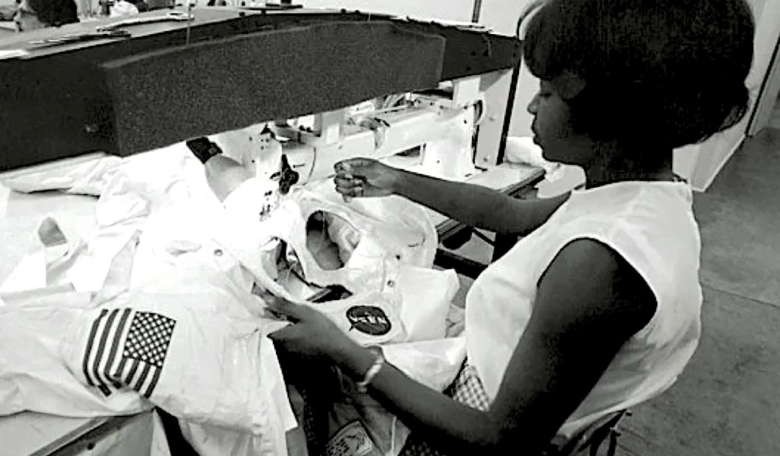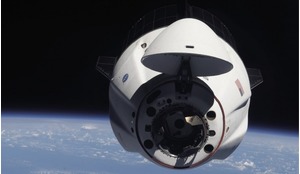Getting safely into space and back is about a lot more than engineering, computer systems, mathematics and physics. The humble craft of sewing is also an essential component of every mission. A spacecraft and its crew cannot survive in space without special textiles to provide protection from low gravity, radiation and the extremes of heat and cold. Here, Harikleia Sirmans explains how NASA’s team of talented seamstresses and textile technicians kept astronauts alive in the cold void of space during the Apollo and Space Shuttle eras by ‘dressing’ both astronauts and spacecraft and looks at the impact of new technical textile programmes and initiatives on the space industry.
The age old craft of sewing remains life-critical to space programmes. NASA seamstresses and textile technicians sew thermal blankets, heatshields, tile gap fillers, parachutes, spacesuits, straps, gloves, sportswear, diapers and more items that keep astronauts healthy, comfortable and safe while living in space.
Hand and machine sewing is an important activity in the space industry – from the fabric used between Space Shuttle tiles to the straps that keep astronauts in place.
In space, everything works differently than on Earth due to the low gravity environment. Sweat, for example, tends to stay on the body and heat remains close to the skin. This can lead to astronauts feeling overheated and uncomfortable. To counteract this, astronauts wear special spacesuits that supply insulation and help to regulate their body temperature.
 Neil Armstrong’s Apollo 11 spacesuit displayed on a table top before the mission was flown. Armstrong described his suit as “tough, reliable and almost cuddly”.
Neil Armstrong’s Apollo 11 spacesuit displayed on a table top before the mission was flown. Armstrong described his suit as “tough, reliable and almost cuddly”.
Designers at NASA keep these conditions in mind when they develop new yarns and fabrics for specific space programmes. They constantly test and evaluate new fabric properties that keep astronauts safe and comfortable. Their purpose is to sustain human life in the extreme environments of outer space. They are lightweight but strong, and they resist extreme heat, cold and ultraviolet radiation. They also are breathable, flexible, fire resistant and can withstand the rigours of spaceflight.
 ILC seamstresses at work on the Apollo spacesuits. The suits had to be stitched piece by piece, with every single stitch inspected.
ILC seamstresses at work on the Apollo spacesuits. The suits had to be stitched piece by piece, with every single stitch inspected.
Dressing astronauts and the Shuttle
Hand and machine sewing is an important activity in the space industry – from the fabric between the Shuttle tiles to the straps that keep the astronauts in place
An ideal example of sewing activity from NASA’s history is the Apollo 11 mission where the survival of astronauts Neil Armstrong, Buzz Aldrin and Michael Collins was literally ‘in the hands’ of talented seamstresses. NASA trained its seamstresses to read blueprints, collaborate with engineers and sew precisely using new threads and multiple thin layers of fabric. Most of these women were employees of the International Latex Corporation, a company that made bras and girdles, and rubber garments, and which continues to sew for NASA today (as ILC Dover).
The seamstresses sewed 21 layers of fine synthetic fabrics together to create suits that would protect the astronauts from extreme heat and cold, the vacuum of space, solar ultraviolet radiation, and possible micrometeorites. They worked under the strictest guidelines. For example, they were denied pins and temporary fasteners, using just their guiding fingers, and they had to sew a tight tolerance stitch of 1/64th of an inch, smaller than the eye of the sewing needle. All but one of these layers were Du Pont fabric and polymer materials: nylon, neoprene-coated nylon, vinyl tubing, Lycra, Nomex, nylon coil, Mylar, Dacron, Kapton, Teflon and Teflon-coated glass fibre. The ultramodern suits were also soft and flexible to allow freedom of movement.
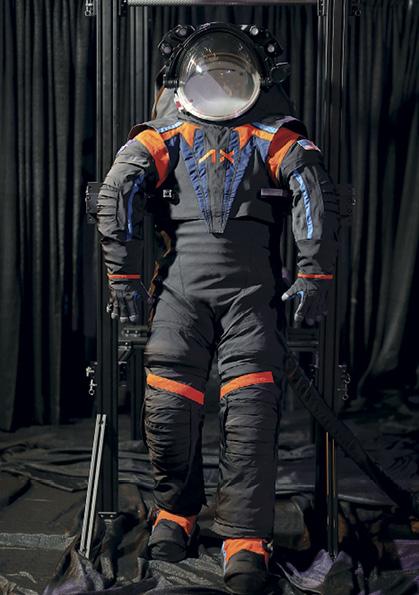 Axiom Space has partnered with Italian luxury fashion house Prada on the Axiom Extravehicular Mobility Unit (AxEMU) spacesuit, intended to be used for the first time on the Artemis III mission to the Moon in 2026 at the earliest.
Axiom Space has partnered with Italian luxury fashion house Prada on the Axiom Extravehicular Mobility Unit (AxEMU) spacesuit, intended to be used for the first time on the Artemis III mission to the Moon in 2026 at the earliest.
For the Apollo 11 mission, the command module that brought the astronauts back to Earth safely deployed three parachutes to slow its fall during reentry. The parachutes were made of polyester and nylon fabrics which were compacted to fit inside the protective aeroshell that carried the parachute and other components needed for entry, descent and landing, such as batteries, electronics and motor rockets. Made of 7200 square feet (669 m²) of strong fabric, each parachute held two million stitches that were all inspected for flaws. To make these parachutes, NASA’s seamstresses sewed together several panels of fabric with 3.5 miles (5.6 km) of thread using Singer sewing machines.
A scientific marvel of that era was the Apollo Guidance Computer (AGC). This computer was as small as a briefcase and portable, had a keyboard, and astronauts could run it themselves. It was designed with a core ‘rope’ memory made by hand. The most amazing fact about its creation is that the memory was woven by a group of expert seamstresses from the local textile industry and the Waltham Watch Company. The women weaved the memory of the computer with copper wire instead of thread, each wire representing a 1 or a 0 in the computer program, and it had to be threaded precisely through magnetic rings using needles. These seamstresses literally weaved the computer’s programming instructions that contained 589,824 ones and zeros!
NASA’s seamstresses also dressed the Space Shuttle. They made multilayered flexible insulation blankets out of silica batting that protected the module from searing heat on reentry. These blankets were quilted insulation pieces in irregular shapes that fitted various parts of the Shuttle’s surface. They were lighter and more durable than tiles that were originally used to cover a Shuttle’s surface.
Another valuable aid was the gap fillers. These resembled thick bookmarks that worked as a barrier to heat. They filled narrow air spaces around doors, windshields, wings, the edge of the shuttle’s nose cap, the heat shield of the engines and other vital parts. They were made of ceramic silica fibres strengthened with aluminium in white or black, depending on their use.
New technical textiles
The space industry depends on technical textiles to complete every mission
NASA has been developing new textiles for space exploration for over 50 years. These unique textiles have allowed humans to live and work in outer space under hazardous conditions whether being inside or outside space vehicles. Each NASA mission requires textiles for specific functions such as spacesuits, fitness wear, covers for logistics supplies, containers that hold food and medical products, sleeping bags, and blankets. Details of some innovative textiles and fibres follow.
Membrane modules
Membrane engineering is an innovative solution needed for deep space exploration. Filtration membranes for air and water purification and recycling are an example of these ‘invisible’ textiles that solve challenging situations while living in space. Membrane modules supply freshwater, oxygen, and energy in a spacecraft. They are also used for human waste management, separation of gas from liquids, cleaning of the atmosphere from carbon dioxide, and growing vegetables in space.
In 2007, the Aquaporin company caught the attention of NASA engineers who were seeking a solution to filter water in space. The goal of filtering water is to decrease the weight and cost of transporting it into space. To this end, Aquaporin joined the Danish Aerospace Company to form the Aquaporin Space Alliance in 2013. Their ongoing collaboration has produced a semi-closed loop water purifying system that uses Aquaporin Inside membranes. The membranes recycle collected sweat and urine and purify it into drinking water for the astronauts. This technology is sponsored by the European Space Agency (ESA), and it was tested for the first time on board the International Space Station (ISS) in 2015 and again in December 2023. Mass production of this membrane was due to start at the end of 2023. The Aquaporin water filtration system can also be used on Earth to treat industrial wastewater and provide clean water during natural disasters.
3-D printed textiles
NASA engineers have been experimenting with 3D printing technology since 2014. In 2017, a team of systems engineers developed a metallic fabric made of interlocking stainless-steel squares. This fabric is shiny on one side with flat squares that reflect heat and light. The other side with the interlocking loops absorbs the light and controls the heat. The fabric looks like ultra-modern chainmail for space knights. It is flexible and strong and could be used for astronauts’ spacesuits and spacecraft as a shield from flying debris or for large antennas and other deployable devices because the material is foldable and its shape can change quickly.
In the future astronauts could even manufacture this fabric themselves using in situ resources, reducing the mass and therefore the cost of goods transported into space. Today, 3D printed textiles are evolving and have been embraced by space engineers and fashion designers alike. They reduce textile waste, recycle plastic and create amazing designs for customised items.
LCP fibre
Liquid Crystal Polymer is an aromatic polymer with excellent mechanical and electro-optical properties, thermal and dimensional stability of fibres, chemical resistance, low moisture absorption, and resistance to radiation. It is used to make fibre, films, and moulding compounds for medical devices, automotive parts, and much more. One current application of LCP is devices for satellite and mobile communications such as 5G communication technology. The 6G network is an evolving technology that will operate on frequencies higher than 5G in the future. Other applications include protective gloves, footwear, tethers, large airships, industrial ropes and cords, heavy lift straps and airbags.
In the aerospace industry, LCP is the optimal choice for the construction of electronic circuits and other flexible components for spacecraft because it is lightweight and can be moulded to any shape. Today, the demand for thin and lightweight electrical components fuels the demand for LCP fibre. Sierra Space is developing the LIFE habitat, an inflatable pressure shell composed of Vectran™ fabric, a material woven from LCP yarn that becomes stronger than steel when inflated on-orbit.
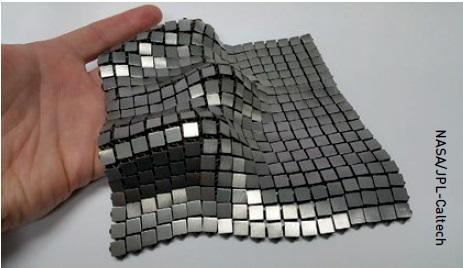 This flexible, strong metallic 3D-printed ‘chainmail’ fabric reflects heat and light on one side and absorbs light and controls heat on the other.
This flexible, strong metallic 3D-printed ‘chainmail’ fabric reflects heat and light on one side and absorbs light and controls heat on the other.
Galvorn yarn
Parachutes, insulation blankets, and even computer memory are a few applications of technical textiles that keep both astronauts and spacecraft safe in the hostile space environment
NASA, US Airforce research agencies and other investors financed DexMat, a climate technology startup, to create a carbon nanomaterial, called Galvorn. DexMat aims to reduce carbon and provide a cleaner environment. Galvorn comes in the form of twisted and braided yarn, fibre, film, and fabric. It is conductive, lightweight, strong, soft, non-toxic, and flameproof. It is 10 times stronger than steel and half the weight of aluminium.
In aerospace, Galvorn materials can be used to build cables and wires, making a spacecraft lightweight, strong and durable. Also, Galvorn film applied over cables and wires would shield them from electromagnetic interference. Galvorn cables are 40 to 60 percent lighter than commercial ones. The Galvorn wires are up to 90 percent lighter than copper wire. A potential use of Galvorn is to protect aircraft wings from lightning strikes. In the future, Galvorn could be made from hydrocarbons, captured carbon, and renewable fuels.
Smart textiles
At the 2023 Advanced Textiles Expo in Florida, USA, representatives of the German Institutes of Textile and Fibre Research Denkendorf (DITF) discussed the many possibilities of smart textiles in biomedical and technical applications. These textiles are practically wearable computers with electronic elements woven into their fibres. Sensor wires are wrapped around ordinary yarns like Lycra, and then knitted, weaved, or embroidered into fabric. The wires have various electrical properties depending on the application.
Sensory wound dressings, which could monitor the moisture level and temperature of chronic wounds, are a possible medical application currently under research. One aerospace application of smart textiles is for monitoring astronauts’ vital signs to monitor stress levels and blood flow from the brain to the heart.
Smart textiles can also measure aspects of the cabin environment such as pressure and gravity force. Another example of smart textiles is piezoelectric fibres, developed by researchers from the Massachusetts Institute of Technology (MIT). These fibres would be sewn into spacesuit materials or integrated into the exterior of spacecraft and satellites to function as sensors. When they sense mechanical stress, like the impact of orbital debris, they would send an electronic signal. Although this technology is currently under development, it could supply hazard alerts of debris impacts.
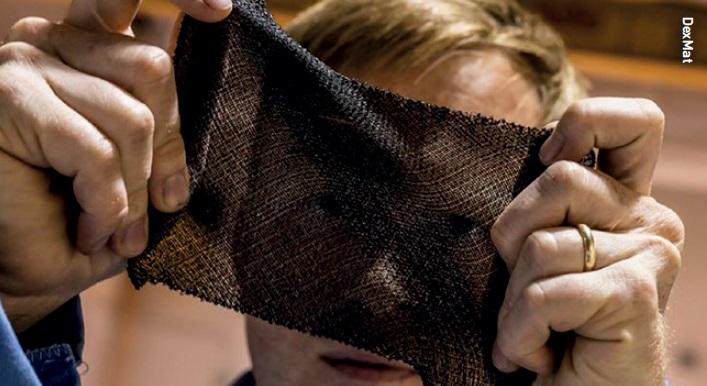 A small prototype square of Galvorn fibre woven into a fabric. Galvorn is stronger than steel, lighter than aluminium and boasts the conductivity of copper.
A small prototype square of Galvorn fibre woven into a fabric. Galvorn is stronger than steel, lighter than aluminium and boasts the conductivity of copper.
NASA’s textile outreach activities
NASA’s textile scientists and engineers have always collaborated with artists, fashion designers, academic institutions, other space agencies, commercial and private companies, and the public through various outreach activities. These collaborations help to visualise the unknown, exotic, and microgravity environments of outer space. They also help to communicate with the public the human experience of being in space. For example, artists use various forms of media such as textiles to create artworks of a futuristic world, and fashion designers create wearable technology. Outreach activities involve programmes and projects that aim to look into the future of our world, explore cosmological phenomena and alien planets, invent space technology, record stories of the emotional and physical experience of living in space, and preserve human discoveries. A few of these programmes related to textile technology include:
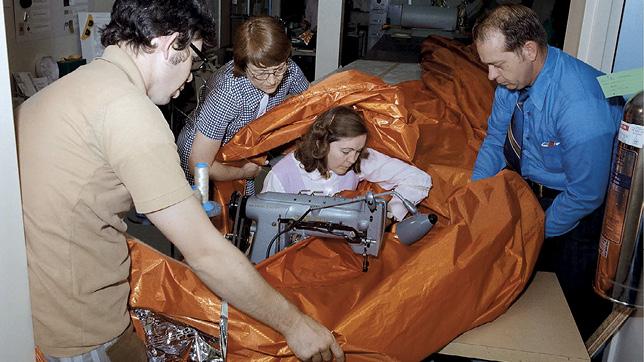 NASA seamstress Aylene Baker pictured stitching part of a replacement heat shield for Skylab in 1973 after the original unexpectedly tore off shortly after launch. The photo is now on display at the NASA Johnson Space Center.
NASA seamstress Aylene Baker pictured stitching part of a replacement heat shield for Skylab in 1973 after the original unexpectedly tore off shortly after launch. The photo is now on display at the NASA Johnson Space Center.
AxEMU
Seamstresses sewed 21 layers of fine synthetic fabrics together to create suits that would protect the astronauts from extreme heat and cold
One of NASA’s goals is to send astronauts back to the Moon by the middle of this decade. The astronauts will land at the lunar south pole, a challenging location because of its extreme temperatures, craters, sharp regolith, shadowed areas and changing illumination conditions. New spacesuits have therefore been developed to keep astronauts safe and comfortable on the lunar surface.
NASA selected Axiom Space to develop the next generation spacesuit for the Artemis III mission to the Moon in 2026. To face this challenge, Axiom Space partnered with Italian fashion house, Prada. Besides designing high fashion clothing, Prada also has technical expertise in raw materials, innovative design, composites and manufacturing techniques which it developed through its involvement in the America’s Cup sailing competition in 2021.
Axiom Space unveiled a prototype of the new spacesuit, the AxEMU, in March 2023. The prototype uses dark grey material and weighs 55 kg. More testing of the suit will follow in NASA’s underwater tank, the Neutral Buoyancy Laboratory at Johnson Space Center in Houston, USA.
Gravity Loading Countermeasure Skinsuit (GLCS)
The GLCS (or skinsuit) is a tight-fitting intravehicular suit with a bidirectional weave design that squeezes the body from the shoulders to the feet. Over the past decade, MIT has developed several versions of GLCS with various modifications, which have been tested on ground, in parabolic flights, and on the ISS. The latest (2023) version is the Mk-8 GLCS which was tested on the ISS during the Axiom Mission 2 (Ax-2) flight in May 2023. An Ax-2 crewmember demonstrated this skinsuit during an exercise session. The suit is designed to simulate some of the effects of gravity to relieve the negative physiological impacts of microgravity on the musculoskeletal system such as back pain and muscle atrophy, and loss of bone density.
HUNCH (sewn flight articles)
HUNCH, the acronym for High School Students United with NASA to Create Hardware, is an educational experience that started in 2003 and continues strong. It engages students to create various products that improve the lives of the astronauts aboard the ISS. Through project-based learning, students gain valuable skills by designing and fabricating real world products for NASA, focussing on one of six areas: Design & Prototyping, Culinary, Sewn Flight Articles, Software, Hardware, Video & Media, Biomedical Science, and Flight Configuration.
The area of Sewn Flight Articles was developed out of NASA’s need to find skilled sewing technicians. During the Shuttle programme it favoured sewn products because they were light in weight, foldable and took up less space, which translated into cost saving. The programme now challenges students to use fabric and other soft materials to create products, including kits for personal items, sleeping bag liners and privacy curtains for use on the ISS.
Materials International Space Station Experiment (MISSE)
The MISSE project is a series of flight experiments that provide valuable insight to researchers about the performance and durability of new materials needed for spacecraft, flight hardware and astronaut clothing that can withstand the harsh space environment. The experiments demonstrate how these materials react when exposed to atomic oxygen, radiation, vacuum, zero gravity, micrometeoroids and extreme temperatures. The experiments, sponsored by NASA, are performed at the MISSE facility, which is attached to the ISS by a robotic arm. The latest experiments (September 2023) included MISSE-18-NASA which tested coatings, quantum dots, lunar regolith composites, and other materials in the low Earth orbit environment for potential future uses.
For example, protective coatings of polymer film with aluminium on the surfaces of a spacecraft could work as a shield from micrometeorites and extreme temperatures.
Likewise, quantum dots, semiconducting nanocrystals with optical and electrical properties, could be used to make a miniature and compact spectrometer. In addition, lunar regolith combined with polymers could be manufactured into building materials on the Moon.
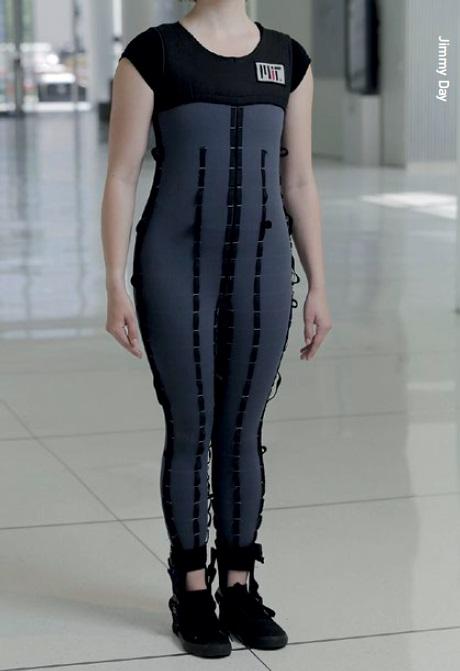 The Gravity Loaded Countermeasure Skinsuit, developed by MIT, is designed to simulate some of the effects of gravity and is intended to supplement exercise during future missions to the Moon and Mars.
The Gravity Loaded Countermeasure Skinsuit, developed by MIT, is designed to simulate some of the effects of gravity and is intended to supplement exercise during future missions to the Moon and Mars.
Space odyssey
Let’s praise the skilled seamstresses who sewed these items one stitch at a time
Space exploration offers new opportunities for science and technology. Great efforts are devoted towards innovative solutions that could also be useful for our daily life. It may not be obvious to the public, but the space industry depends on technical textiles to complete every mission.
To travel and live in space, humans need everything from food containers to clothing, spacesuits, heat shields and much more. Technical textiles help to fulfil these needs by supplying a safe, comfortable and functional habitat. They were designed to protect the astronauts from the harsh environment of space as well as to ‘dress’ the spacecraft so that it can sustain human life by creating an Earth-like environment. For example, spacesuits were designed to be flexible and protect astronauts against the vacuum of space.
NASA and other space agencies have spent significant effort in researching, developing, and refining technical textiles for specific functions that solve special challenges during planetary explorations and space travel. Parachutes, insulation blankets and even computer memory are a few applications of technical textiles that keep both astronauts and spacecraft safe in the hostile space environment.
Also, let’s praise the skilled seamstresses who sewed these items one stitch at a time. Sewing and textile innovation are two activities still thriving in the space industry. In NASA, people with meticulous sewing skills are always needed.
The future of scientific research and space exploration depends on technicians who can think creatively – and operate a sewing machine. For these reasons, NASA develops partnerships with textile manufacturers, fashion designers, and schools through unique programmes and projects to create innovative materials for future space odysseys.
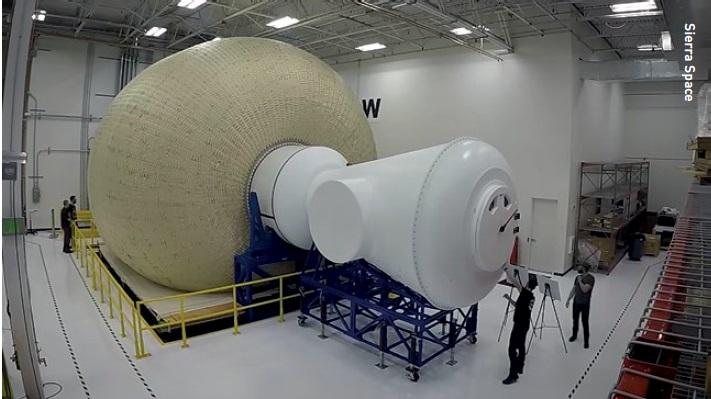 Sierra Space is developing the LIFE habitat an inflatable pressure shell composed of Vectran™ fabric, a material woven from liquid crystal polymer yarn that becomes stronger than steel when inflated on-orbit.
Sierra Space is developing the LIFE habitat an inflatable pressure shell composed of Vectran™ fabric, a material woven from liquid crystal polymer yarn that becomes stronger than steel when inflated on-orbit.
About the author
Harikleia Sirmans is a Librarian and NACO Cataloguer at Valdosta State University, USA, and owner of Grecian Needle, where she produces clothing and fabric arts. She holds an MA in Library and Information Science, and a BA in English Language and Writing, both from Valdosta State University. She also studied Pattern Cutting at the London Centre for Fashion Studies and has has won the Valdosta Awards Program Best Dressmaker award three times.





